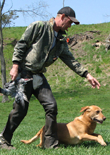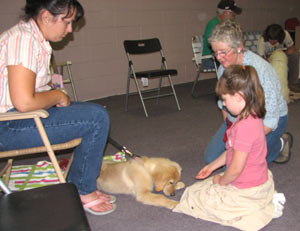A Comprehensive History of Dog Training
By Sally Gutteridge | Posts

Dog training has evolved through the centuries and will continue to evolve in the future as we continue to refine and develop new training techniques. Positive reinforcement based training was something unheard of 50 years ago, and now in 2011 it is a training technique used by all major dog training centers around the world.
Let’s explore the history of dog training…
 Hunting Training
Hunting Training
The earliest dog training involved teaching dogs to assist in hunting. The hunters needed help when they went hunting and a dog could assist them in finding and retrieving their prey. There is nothing quite like hunting near a lake and getting your dog to swim in near freezing temperature just to retrieve a prize. This help the hunters tremendously and many hunting breeds like the Spaniels, Terriers, Pointers and Retrievers are still employed today.
 Military Training
Military Training
When World War I began dogs were often used in combat for various purposes. The military needed dogs to be trained quickly so they would train many dogs at the same time. Some of the dogs were trained as guard dogs and others were trained to detect mines and explosives.
The early military dog training techniques were ones of constant correction. The dog would be physically punished for not obeying the trainer’s commands. The punitive system went in to include collars with shocking systems. The idea of dominating the dog and becoming the Alpha and the pack was born and quickly spread all over the world after the war.
 Modern Dog Training
Modern Dog Training
After World War I it was considered normal to punish the dog for any misdeeds committed by the dog. Punishment equipment was invented like the prong and choke collars. The idea was that if a behavior is punished then the dog would learn to never do it again.
For example, training a dog to walk loosely on a leash was done by punishing the dog any time he pulled on the leash or walked out of line.
Fortunately, in 2011 we have evolved from these dog training techniques and are now getting the dog to do what we want on his own by means of positive reinforcements.
 Assistance Dogs
Assistance Dogs
Dogs have been shown to be terrific assets to those with visual or auditory impairments as well as those with limited mobility. These dogs must be highly trained as well as companionable. In addition, they are carefully selected as they must have the right physical ability and temperament. They then are put through an intense training that is reward based (positive reinforcements).
These dogs are trained to ignore distractions and to take direction. They are taught to lead or communicate and follow commands. It is imperative that these animals be thoroughly trained as any mishaps can endanger the lives of the owner. Most assistance dogs are trained by professionals and then introduced to their owner or trained alongside their owner.
 Police and Drug Dogs
Police and Drug Dogs
Drug, Search and Rescue, or Bomb Squad dogs are highly trained in tracking and alerting skills. Police and protection dogs are trained in controlled aggression. Each animal is highly skilled in their respective field and are not interchangeable in other areas. Dogs trained in tracking abilities are less likely to be trained using heavy handed techniques, while police and protection dogs are.
Medical Dogs
The latest dog training is taking place in the medical field. Dogs are being trained to use their highly sensitive noses and sniff out medical conditions, such as cancer. So far studies on the subject are limited but they show promise and could potentially lead to saving human lives through early detection.
 Dog Sports
Dog Sports
Popular dog sports include Flyball and Agility. Flyball is a relay race with four dogs, and Agility is an obstacle course set up for a single dog to run while being coaxed by his owner. Training to run these sports is almost always based on positive reinforcement. Practice and consistency are also very important.
 Family Pets
Family Pets
While much of modern training still involves punitive systems, positive reward based systems can be more effective and easier on everyone. Tricks and basic commands can all be taught gently and easily using positive reinforcement methods. The sheer number of methods and options we have today are indicative of how much joy and help they can bring into our lives. They also show our dedication to finding more humane and loving dog training techniques to train our dogs.
Session expired
Please log in again. The login page will open in a new tab. After logging in you can close it and return to this page.